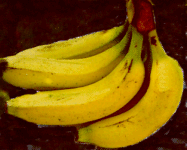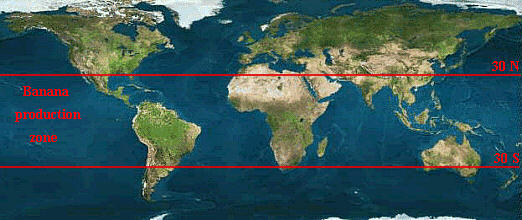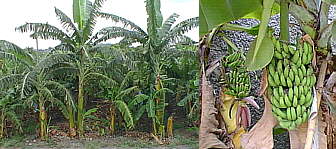Jamaican bananas and plantains
Authorities believe that bananas originated in the hot, tropical
regions of southern Asia and that the banana was one of the first
foods that man cultivated. For this to be successful, a tropical
climate where the temperature stays between 10°C and 40°C is
required which roughly translates to latitudes between 30S and
30N.
- Alexander the Great and his troops are believed to have found
bananas growing in the Valley of the Indus river as early as 326
B.C., during their abortive march through India trying to reach
the Ocean.
- The first reference to bananas in the Chinese literature
comes from Yang Fu, an official at the end of the Later Han
Dynasty around the 2nd century A.D. He used the names
pa-chiao and kan-chiao.
- Pliny (around 67 AD) mentions that the fruit was the "food of
the sages", which gave rise to Musa sapientum.
- The term "banana" is believed to be of African origin being
given to the fruit by a tribe in the African Congo.
- During the 1500's, as Spanish Explorers began to visit the
New World, the banana traveled with them. Friar Tomas de Berlanga
is claimed to have introduced the first banana root to San
Domingo in 1516. However, some botanists hold that bananas were
found in the New World long before Christopher Columbus.

The Gros Michel is said to have been introduced to Jamaica by
Jean Francois Pouyat, a French botanist and chemist who settled
here in 1820. He brought the fruit back from Martinique to his
coffee estate in an attempt perhaps to diversify his produce. It
was originally called the "Martinique Banana-Pouyat" then later
this became the "Martinique Banana". History records that the
Agricultural Society in Jamaica awarded Pouyat a doubloon for his
effort in introducing such a valuable variety.
Jamaica was the first commercial producer of bananas in the
Western Hemisphere. Thanks in part to shipping and refrigeration,
bananas were able to be sent long distances. Elders and Fyffes
established the Imperial Direct Line between Bristol and Jamaica
in 1901. This was taken over by the United Fruit Company in
1910.
By the mid 1940's the banana industry in Jamaica had suffered
greatly due to the Sigatoka and Panama disease to which the Gros
Michel were not resistant.
"The banana and plantain were for many years treated as two
species, Musa sapientum and M. paradisiaca.
These are now known to have originated as hybrids between the
species M acuminata Colla (1820) and M.
balbisiana Colla (1820) and their logical classification
depends on the analysis of the contribution to any hybrid by each
of these species respectively and the determination of
ploidy".
"Flowering Plants of Jamaica", C.D. Adams, Robert MacLehose and
Company Limited, The University Press, Glascow, 1972.
Growing bananas
Bananas are propagated by division of the main stem (rhizome), or
by planting suckers that arise by the out-growth of buds on the
stem.
When the plant reaches flowering age a large red bud emerges
from the center and extends downward gradually opening up to
expose tiered rows of tiny flowers.
Each of these flowers becomes an individual banana, also
known as a "finger". Each row has approximately 14 to 20 fingers
that make up a bunch or "hand". As the stem develops, 7 to 9
hands are formed.
Once the plant has fruited it dies, but a new plant has
sprung up around its base. The whole process takes around
eighteen months.
Chemistry of bananas
One look at a banana tells you its exact stage of ripeness. A
dark green peel means it's very firm, as the banana ripens, the
color of the peel changes to yellow. During this process, the
starch within the banana converts to sugar - thus riper bananas
have a much sweeter taste.
sugars
acids
volatiles
pigments
References
"Bananas", H.W. Von Loesecke, revised 2nd edition, Interscience
Publishers, Inc. New York, 1950
Return to links to the chemistry of other Jamaican items, including
spices and fruit and vegetables.
Copyright © 1997-2013 by Robert John
Lancashire, all rights reserved.
Created and maintained by Prof. Robert J.
Lancashire,
The Department of Chemistry, University of the West Indies,
Mona Campus, Kingston 7, Jamaica.
Created June 1997. Links checked and/or last modified
17th November, 2013.
URL
http://wwwchem.uwimona.edu.jm/lectures/banana.html



